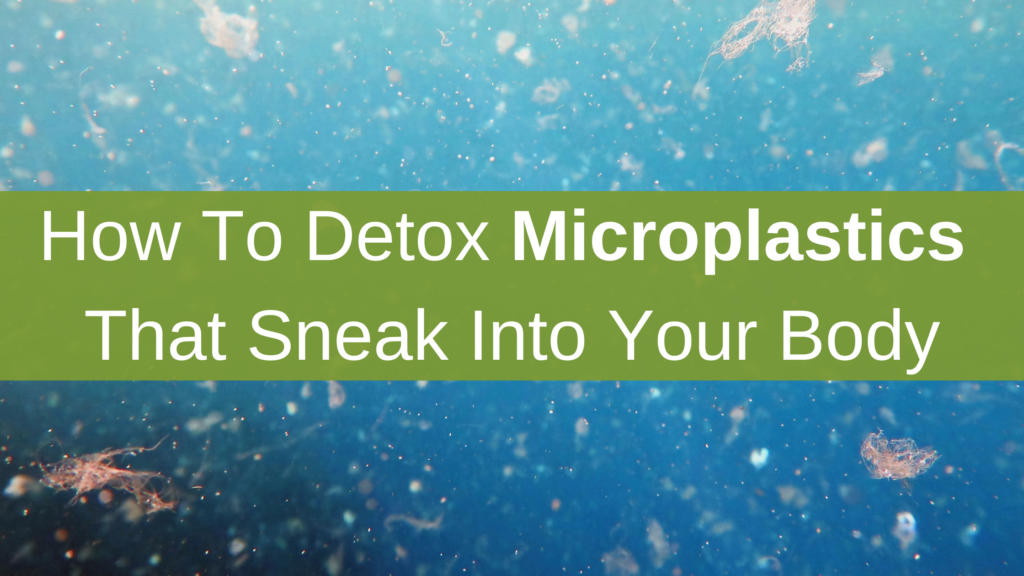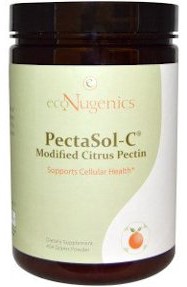
Quick Read:
- Microplastics are all around you (water/food containers, table salt, personal care products, city dust, plastic-lined cups, etc.).
- Your body was not designed to handle being bombarded by microplastics and requires assistance in detoxifying them.
- They can damage your healing journey, but there are specific things you can do today to reduce your exposure and detox them.
The toxic plastic in your throwaway water bottle and takeout containers is sneaking its way into your body. So are the tiny, hidden plastics in your air, fish, beauty products, water… they are everywhere you are. Labs have found microplastics in breast milk, organs, blood, livers, digestive tracts, and even placentas. (Study) One woman in the Breast Cancer Conqueror community even reported that during her first EBOO therapy session, they had to stop and clean out the machine due to clogging from microplastics!
You can’t see them. You can’t taste them. But clearly they’re there, and silently working against your healing efforts. Continue reading to learn about microplastics, why you should avoid them, and how to effectively eliminate them from your body.

What Are Microplastics?
Microplastics are exactly what they sound like—tiny plastic particles, usually smaller than 5 millimeters in size (some are so small they’re called nanoplastics). These come from the breakdown of larger plastic waste, as well as from everyday items like:
- Food packaging
- Synthetic clothing (like polyester)
- Personal care products (yes, even some scrubs and toothpastes!)
- Bottled water and plastic-lined coffee cups
- Car tires and city dust
- Disposable kitchen items (cling wrap, utensils, straws, etc.)
These microscopic invaders are now everywhere—in our oceans, soil, drinking water, food supply, and, of course, your body.
Here’s how they sneak in:
- Inhalation: Dust in your home or city air can carry microplastics. If you’ve ever cleaned out your dryer lint trap, you’ve seen a hotbed of potential particles.
- Ingestion: Microplastics are found in fish, table salt, produce, and even bottled water. This study estimated that the average person ingests about a credit card’s worth of plastic every week!
- Absorption through the skin: Especially when using beauty or hygiene products that contain microbeads or when touching plastic items with heat (like handling hot food in plastic containers).
Once in the body, these particles don’t just “pass through,” they set up camp, triggering a host of horrible responses.
Why You Should Be Concerned About Microplastics.
Let’s connect the dots.
Microplastics often contain or attract endocrine-disrupting chemicals (EDCs) like phthalates, bisphenol A (BPA), dioxins, and PCBs. These chemical hitchhikers may contribute to cancer development in a number of ways, including:
- Carriers of Toxic Pollutants: They transport harmful chemicals and pollutants, potentially increasing exposure to carcinogens.
- Inflammation: About 95% of ALL cancers have inflammation in common, impacting all stages of tumor development, including initiation, progression, and metastasis. However, inflammation is something you have control over. Click here to learn more about how to lower your inflammation levels.
- DNA Damage: Cancer is a cellular problem, and DNA damage can lead to cancer-causing mutations. For insight on how to repair your DNA, please review this blog post.
- Oxidative Stress: It occurs when there’s an imbalance between the production of reactive oxygen species (ROS) and the body’s ability to neutralize them with antioxidants. This imbalance can lead to mutations in genes that regulate cell growth and division, potentially triggering the development of cancer. (Study)
- Hormone Disruption: Chemicals in plastics, such as BPA, can disrupt hormone balance, throwing off your EQ Ratio. Microplastics are also filled with “dirty estrogens,” which can stimulate cancer cell growth and impair your body’s natural healing mechanisms.
- Cellular Pathway Disruption: They can interfere with cellular processes, including cell growth, division, and migration, contributing to cancer development.
Clearly, these tiny and toxic plastics have got to go!
How to Reduce Your Microplastic Exposure.
If you are feeling overwhelmed at this point, remember the goal is progress, not perfection. It’s not realistic to live in a glass bubble, but it’s doable to make simple swaps that reduce your plastic exposure.
- Never drink tap water or from plastic bottles. Tap water is a chemical cocktail (learn why here). However, you can easily remedy the situation with a home water filter (we suggest these) and carry your non-plastic water bottle when you leave the house.
- Never put hot food or liquids in plastic containers. This even goes for coffee in plastic-lined cups.
- Clean up your personal care routine. Avoid anything with “polyethylene” or “polypropylene” in the ingredients. Here are nontoxic beauty products that we love.
- Choose natural fabrics. Cotton, wool, hemp, and bamboo shed far fewer microfibers than synthetic fabrics.
- Consider a home air filter and vacuum often with a HEPA filter. Dust is a major microplastic transporter.
- Buy organic produce. Plastic mulch is often used in conventional farming, and pesticide-laden soil attracts even more plastic contaminants.
Can You Detoxify Microplastics from Your Body?
Yes—and your body wants (and needs) to get rid of them ASAP. However, your pathways do need support because they were not designed to be bombarded with an onslaught of microplastics and toxins 24/7.
Here are a few ways you can detox from microplastics:
-
- Bust out toxins with binders: Activated charcoal, bentonite clay, or chlorella can help escort toxins out of the body. The binder our coaches suggest is Modified Citrus Pectin. It’s a highly effective binder, and it supports your healing in several ways: reducing fatigue, optimizing treatments, promoting apoptosis, and more. You’ll learn about these benefits and others in this blog post.
- Get sweaty with infrared sauna sessions: Sweating through saunas (especially infrared) is one of the best ways to push out fat-stored toxins like plasticizers. For more insight into saunas and the type we suggest, please review this blog post.
- Eat fiber-rich, cruciferous veggies: Broccoli, cauliflower, and Brussels sprouts support liver detox and estrogen metabolism. For a highly effective way to consume one of the most helpful nutrients in broccoli, take our Brocco Power supplement daily. One capsule is equal to 500 grams of fresh broccoli!
- Support your methylation pathways: Use targeted supplements like Methyl Support to optimize gene expression and estrogen detox.
- Do coffee enemas: They are one of Dr. V’s go-to detox methods, and you can use our step-by-step guide here.
- Consciously lower stress levels: Chronic stress slows detox and increases inflammation. Learn specific ways to manage your stress via this blog post.
 Step Into YOUR Power.
Step Into YOUR Power.
Microplastics are everywhere, but so is your power to choose healing. We are here to help you create a healing environment that gives your body the best possible chance to thrive.
To learn more about building a transformative healing plan that works for you (not just a treatment plan your doctor gives you), check out our self-paced, online program—Conquering Breast Cancer Together: A Balanced Approach to YOUR Healing Journey. It will empower you with education, wisdom, and support so that you may find clarity, community, and a path to healing. Healing is for you. Choose it!
